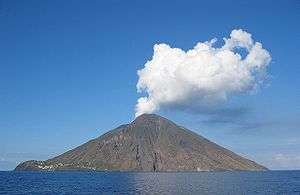Volcanology of Italy
Italy is a volcanically active country, containing the only active volcanoes in mainland Europe. The country's volcanism is due chiefly to the presence, a short distance to the south, of the boundary between the Eurasian Plate and the African Plate. The magma erupted by Italy's volcanoes is thought to result from the subduction and melting of one plate below another.
Three main clusters of volcanism exist: a line of volcanic centres running northwest along the central part of the Italian mainland (see: Campanian volcanic arc); a cluster in the northeast of Sicily; and another cluster around the Mediterranean island of Pantelleria.
Active volcanoes

Three of Italy's volcanoes have erupted in the last hundred years:
- Mount Etna, on Sicily (continuous activity)
- Stromboli, one of the Aeolian Islands (continuous activity)
- Mount Vesuvius, near Naples (last erupted in 1944); the only active volcano in mainland Europe.
Dormant volcanoes
At least nine other volcanic centres have seen eruptions in historic times, including some submarine volcanoes (seamounts). In order of the most recent eruptions, they are:
- Pantelleria, off the coast of Tunisia, probably last erupted around 1000 BC. There was a submarine eruption a few kilometres north-east of the island in 1891, which was probably related to the main volcano.
- Vulcano, another of the Aeolian Islands, last erupted in 1888-1890.
- The short-lived Isola Ferdinandea erupted a few kilometres north-west of Pantelleria in 1831 and rose to a maximum height of 63 metres, but was eroded back down to sea level by 1835. The summit is now a few metres below the surface. A swarm of small earthquakes centred on the seamount in 2002 was thought to indicate that magma was moving beneath the volcano, but no eruption occurred.
- Vulcanello is a small volcano connected by an isthmus to the island of Vulcano, which erupted out of the sea in 183 BC and showed occasional activity thereafter until the 16th century.
- Campi Flegrei, a huge caldera containing the western area of Naples, erupted in 1538, generating the small tuff cone named Monte Nuovo (new mountain).
- Ischia, an island 20 kilometres west of Naples, last erupted in 1302.
- Larderello, in southern Tuscany, last erupted in 1282 with a small phreatic eruption
- Lipari, an island a couple of kilometres from Vulcano, has a volcano which last erupted in 729.
- Vulsini (Bolsena volcano, Latera volcano, Montefiascone volcano), a caldera complex at the northern end of the Roman magmatic province (at the north of Cimini volcanic complex). Last erupted in 104 BC.
- Monte Albano, a quiescent volcanic complex near Rome (south). The most recent eruptions produced Lake Nemi and Lake Albano. Last erupted in 5000 BC.
- Sabatini (Bracciano volcano and Sacrofano volcano), a volcanic complex and caldera near Rome (north). Last erupted in 40,000 BC.
- Cimini (Cimino volcano and Vico volcano), a volcanic complex and caldera at the north of Sabatini volcanic complex. Last erupted in 90,000 BC.
Status
Several volcanoes in Italy have reportedly erupted in the past, but these events are not confirmed:
- Roccamonfina, a volcanic complex 50 km north of Naples, reportedly erupted in 270 BC, but it is not sure if this event was really a volcanic eruption or not.
- Monte Vulture, a volcanic complex in Basilicata. Last erupted 40,000 BC.
- Marsili, a submarine volcano in the Tyrrhenian Sea. Marsili rises 3,000 metres from the seabed in the Tyrrhenian sea southwest of Naples. Its summit is only 500 metres below the surface of the water. The volcano has not erupted during recorded history, but is active.[1]
